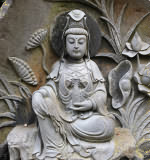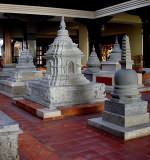Истоки индо-европейских языков: Часть VII
Шумерская цивилизация
Introduction
Hi, Andrés Muni again. As the previous one, the following document has plenty of names: names of languages, regions, countries, etc.
I have attempted to translate all those names into English properly to a certain extent, but since my knowledge of English language is limited, I maybe made some mistakes. Besides, some of them are in Spanish, because I do not know their respective translation.
If you note some errors or know a translation for a certain word, please e-mail me in order to correct the mistake or translate the word. I have marked with an asterisk the words with a problematical translation.
In this document, we will study the ancient Sumerian civilization, an ancient people who practically laid the foundations of our present civilization. Enjoy.
The first writing system
The discovery of the Sumerian civilization marks the culmination of the systematical exploration of the subsoil in the Near East, which got started in the late nineteenth-century. In the middle of that century, it was possible to spell and read the documents made with clay and covered with strange cuneiform or wedge-shaped signs, which had been found in the territory of Iraq a long time ago. This fact brought about the proliferation of excavations in the ancient Mesopotamia, just as it occurred in the Valley of Kings when the hieroglyphics were deciphered. Since these excavations were made in depth, they caused the vestiges or traces arranged in parallel layers to outcrop.
After having gone through layers with Arabian, Greek and Persian traces, the excavations got to testimonies dating from the middle of the first millennium B.C. The exploration thus reached the layer that stored the vast majority of the cuneiform documents. Consequently, were discovered the palaces, statues, treasures and weapons of the great Assyrian kings, who are mentioned in the Old Testament due to their conquests. In this way, the Assyriology was born as a scientific discipline from the cuneiform texts and the archeology of Mesopotamia.
Under that layer, other layers were discovered, which led to conclude that the apogee of the bellicose Assyrians proceeding from the north had been preceded in about one millennium by a people possessing a higher culture. These people originating from southern Mesopotamia were based on the Babylonians, whose code of laws (Hammurabi) symbolized their great cultural development and political equilibrium.
It was found out that the aforesaid code along with documents of that time were identical with the Assyrian annals and tablets, but with differences which determined that the Assyrian and Babylonian dialects came from an only language known as Akkadian. The Akkadian language is related to the Arabian, Aramean and Hebrew languages, and it is classified as a Semitic one. Then, the conclusion was that the empires of Babylon (in the early second millennium B.C.) and Nineveh (in the early first millennium B.C.) were of Semitic origin.
At the time that those archeological excavations were made, the cuneiform writing represented an enigma. This writing is composed of a large quantity of signs or characters (300 at its height), consisting of wedge-like strokes engraved on raw clay.
Initially, these linear drawings stood for concrete specific objects. In a second stage, each of the signs of this writing can be read in a text in two different ways:
- As the name of the object which originally was represented by that character.
- As the mark of a sound (syllable), but never an elemental irreducible sound like, for instance, those of the Latin alphabet.
Therefore, the cuneiform writing is ambivalent (both ideographic and phonetic). Thus, the drawing of a spike (e.g. a spike of wheat) within a cuneiform text can be read, according to the context, as the names of "grains" or the syllable "she". In the same way, the engraving of a bird was ideographically interpreted as "volatile", o else phonetically as the syllable "hu".
As I mentioned previously, the cuneiform signs were initially just a reproduction of objetcs. With time, they noticed that by means of such a rudimentary procedure as this, just a limited quantity of all that is possible to express in articulate language could be expressed. Only concrete typical objects could be depicted, but not actions or abstractions. For that reason, the solution was to disassociate in the character its reference to the object which reproduced, on one hand, and its pronunciation (phonetic value), on the other hand. So, the creators of this writing could write all that the spoken language expressed.
For example, the abstract word "vision" in Akkadian language is "shehu", which could be represented by the drawing of a spike (i.e. a spike of a grain) followed by that of a bird (she + hu), but neither characters is related to a grain or something volatile in this case. Notwithstanding, in a different part of the text, those two characters might be directly translated as cereal and bird. This fact causes the decipherment of the cuneiform signs to be greatly difficult. Anyway, that difficulty may be overcome through a deep knowledge of the language.
Because the Akkadian and Semitic name of the objects indicated by the cuneiform signs never corresponded to the phonetic value of those characters, it was inferred that the people who invented the cuneiform writing could not be Semites. The existence of another different and more ancient civilization prior to the Semitic Akkadians was then presumed.
The archeological excavations offered new cuneiform inscriptions, which, unlike the Babylonian and Assyrian texts, were written with ideograms only used due to their objective value, without any possibility of representing direct phonetic reading in either Akkadian or Semitic languages. Finally, the people who lived in southern Mesopotamia, whose monuments and cities underlying the Babylonian traces (2000 B.C.), were identified with the people who invented the cuneiform script.
As the ancient texts designated that zone of Mesopotamia adjacent to the Persian Gulf by the name of "Country of Sumer" (from the Akkadian term "shumerum"), it was agreed to call the predecessors of the Semitic Babylonians "Sumerians". In the course of time, the investigations advanced until it was possible to reconstruct the Sumerian language, which had been lost for thousands years. Besides, this language had never could be classified within the well-known linguistic families.
The Sumerian language is really strange as far as its vocabulary (mostly monosyllabic) and even more its grammar (reconstructed in the most part) are concerned. In it, a big portion of the linguistic categories, which are indispensable according to our own way of viewing and expressing the things, is absent. As it was above mentioned, the Sumerian world is a finding of the nineteenth-century. It is the first civilization of the world, with the complexities this fact implies, namely: social and political organization, foundation of cities and states, creation of institutions, laws, organized production of assets, regulation of commerce, monumental artistic manifestations, and the invention of a writing system that would let knowledge be fixed and propagated. The appearance of this civilization dates from the fourth millennium B.C., in low Mesopotamia, between the rivers Tigris and Euphrates, to the south of Baghdad.
Two very ancient civilizations such as the Egyptian one and the Protoindian civilization of the Indus valley, are several centuries later than that of Sumer. Unlike Egypt and its pyramids, which reminds us of the glories of that civilization, or Israel and Greece, which built monuments that reminds us of their golden ages, in Sumer no testimonies of its past splendor were left. All that we know about Sumer at present, comes from the archeological excavations. All knowledge about this civilization has been extracted from clay tablets containing plenty of tiny cuneiform characters. These texts that are so difficult of being deciphered and understood, have been extracted by the hundreds of thousands, and they cover all aspects related to the writers' lives: government, justice administration, economy, everyday life, science, history, literature and religion.
Historical backgrounds: The first cities
The first human settlements in Mesopotamia go back to about 100,000 years. These settlements are situated on the sides of the mountains in northern Iraq, mainly in the Kurdish country. The traces that have been found date from a long time before the emergence of the civilization settled down in the valley delimited by the Tigris and Euphrates rivers.
Over a long period of time extending up to 6000 B.C., men lived in isolation, forming families or little groups, in caves or temporary camps, making rudimentary utensils. Hunting and daily gathering were their only means of livelihood.
About the period 5000-4500 B.C., the first cities appear, and a gradual desiccation of the region situated in the Tigris valley makes possible a larger occupation toward the Persian Gulf. Man makes more perfected and complex utensils, begins to cultivate (i.e. agriculture), domesticates animals, works the copper (the first metal) and develops pottery, gets organized in societies or communities, and constructs the first public buildings and temples. This culture known as "Ubaidian" [since the El-Obeid tell (a kind of mound containing tablets) is the central point of activity] arrived at its height in the late fifth millennium and the early fourth millennium B.C.
About 3500 B.C., in southern Mesopotamia and on the banks of the Persian Gulf, the Sumerian civilization was born. It is thought that they arrived in the region as conquerors and quickly adopted and absorbed the culture of their predecessors until it became part of their own idiosyncrasy. This stage of Sumerian settlement in low Mesopotamia is called "age of Uruk", and lasted about eight centuries. Here, the Sumerian texts are very strange and make impossible to historically situate this age. In fact, it constitutes quite a protohistory which is being reconstructed from the archeological findings.
The Sumerian history started in the protodynastic epoch (2700-2300 B.C.). This epoch fully developed the civilization which had started a few centuries before. Sumer was organized and distributed in the form of little urban states and rural areas grouped around a fortified capital city surrounded by walls. This protodynastic epoch is characterized by the fights between the city-states that aspired after the hegemony. At the end of this period, Sumer is unified around the religious centre of Uruk, and ruled by just one monarch: Lugalzaggesi (ex-ruler of the city-state known as Umma). In spite of these tendencies to an imperial expansion, it was not the Sumerians who established the first Mesopotamian empire, but the peoples of Semitic origin.
The Semites were ancient nomadic Bedouins of the Syrian-Arabian desert. Bands of those Bedouins gradually infiltrated the Sumerians and their predecessors in the low valley formed by the Tigris and Euphrates rivers. This infiltration occurred specially to the north of that valley, in the country of Akkad. About 2300 B.C., one of those kings, Sargon of Akkad (the old man) unified the whole Mesopotamia (Sumer included), apart from Elam (to the east) and a portion of Syria and Asia Minor (to the west). Thus, the Akkadian period commenced and would last two centuries.
This period ended with the invasion of the Guti, semibarbarian highlanders from Kurdistan, who put an end to the empire as well as the dynasty of Sargon. A century later (2000 B.C.), a new epoch for the Sumerian civilization dawned, the last and most brilliant one of its history. It is the epoch of the third Ur (i.e. the third epoch of Ur city). This epoch is also known as Neosumerian, and is characterized by an extraordinary renascence. Its domain reached, to the east, Elam and Persia; to the west, Cappadocia and Syria; and to the north, Armenia. Thus, its culture influenced the entire Near East.
In the early second millennium B.C., other Semitic bands of the Syrian-Arabian desert, the Amorites, infiltrated the Sumerian people of the third Ur and put an end to this dynasty. The meridional kingdoms of Isin and Larsa, strongly influenced by the Semitic culture, resisted for a while but they were finally conquered and absorbed by the power of the Amorite king known as Hammurabi. Hammurabi was the king who created the Semitic empire of Babylon (1750 B.C.). At this point, the Sumerian history comes to an end, overwhelmed by the Semitic predominance. However, although their political and ethnical existence had come to an end, they persisted by means of the force of their own culture. The Babylonians, later the Assyrians, Anatolian Hittites and the Hebrew picked up and continued the Sumerian civilization.
These Semitic nomadic peoples of Mesopotamia incorporated all relating to a civilized life from the Sumerians: political and social institutions, administrative organization, laws, industrial techniques, science, religious forms and contents, and the cuneiform writing, which was adapted to their own language. One of the marks of this influence during the entire history of Babylon and Assyria lies in that, even one century before the Christian era, the Semites of Mesopotamia still kept the Sumerian language as a liturgical scientific language, in the same way as Latin language was used in the kingdoms of the West during the Middle Ages.
The possibility of understanding all this enormous mass of texts is due to the efforts of Henry Rawlison, who, in the late nineteenth-century, found the key to the history of Mesopotamia when he deciphered the cuneiform inscriptions of the Behistun rock. This rock was a kind of Rosetta stone. As you surely know, the Rosetta stone allowed Champolion to decipher and interpret the Egyptian hieroglyphics.
The so-called Behistun rock or stone is located near Kermanshah (Iran) and the route communicating Hamadan with Babylon. It is a monument carved out of the side of a cliff or steep at more than 166 feet (about 50 meters) high above the bottom of the valley, a fact that makes it inaccessible. There, Darius the First is depicted on a bas-relief with the right foot placed on the magician Gaumata. In turn, those who rebelled against the sovereign are seen tied before him. On both sides and below the scene, there are fourteen columns full of inscriptions written in three languages: (1) Ancient Persian, (2) Akkadian and (3) Elamitic. These texts explain the promotion of Darius to the Persian throne and celebrate the victories together with the pacification lastly attained by the king, exactly as ordered by him in 520 B.C.
The text was transcribed in 1837 by Henry C. Rawlinson, who underwent enormous difficulties because of its location. This is the transcription of some paragraphs:
"I am Darius, the Great King, King of kings, King of Persia, King of the countries, son of Vishtaspa, grandson of Arshama, an Achaemenes."
"Darius the King speaks: My father was Hystaspes (Vishtaspa); the father of Hystaspes was Arsames (Arshama); the father of Arsames was Ariaramnes (Ariyaramna); the father of Ariaramnes was Teispes (Cispis); the father of Teispes was Achaemenes (Haxamanis)."
"Darius the King speaks: For this reason, we are known as Achaemenes. We have been nobles for a long time. For a long time, our family has flaunted royalty."
"Darius the King speaks: Eight members of our family were kings formerly. I am the ninth. Nine kings have successively ruled."
"Darius the King speaks: I am king by will of Ahuramazda. Ahuramazda gave royalty to me."
"Darius the King speaks: These are the regions that surrendered themselves to me. I became their king by will of Ahuramazda: Persia, Elam, Babylon, Assyria, Arabia, Egypt, and also those which are next to the sea, Sardes, Ionia, Media, Urartu, Cappadocia, Parthia, Drangiana, Aria, Chorasmia, Bactriana, Sogdiana, Gandhara, Scythia, Sattagydia, Arachosia and Maka, totaling twenty-three regions."
"Darius the King speaks: These are the regions that surrendered to me. By will of Ahuramazda they became my domains. They deliver a tribute to me. What I order them to do, they do it, by day or by night."
"Darius the King speaks: Ahuramazda gave royalty to me. Ahuramazda helped me and thus I could hold royalty. By will of Ahuramazda, I flaunt royalty."
"Darius the King speaks: This is what I did, by will of Ahuramazda, after becoming a king."
Afterward, occurs the detailed account of the successive victories of Darius over the rebels until the definitive pacification of the Persian domains was accomplished:
"Darius the King speaks: This is what did. By will of Ahuramazda, I did it in one year. You, who are reading this inscription in the future, let that which I affirm convince you."
"Darius the King speaks: I swear by Ahuramazda that this of which I have spoken is true and not false."
"Darius the King speaks: By will of Ahuramazda, a lot more facts I carried out, which were not recorded on this inscription. They have not been described here lest my facts appear to be excessive, not convincing and false to those who will read the inscription in the future."
"Darius the King speaks: This is the inscription that I have made by will of Ahuramazda."
"Moreover, it was also transcribed in Aryan language and has been written on clay tablets and parchments."
"Besides, I had my own form sculptured. Again, I got my lineage engraved on the inscription. This inscription was written and read before me. Afterward, I had this text sent to all places of those regions."
Recent epoch
War in Iraq, at the beginning of this century, aside from the tremendous toll, has caused an immense irreparable damage to the cultural and historical patrimony of humanity.
Since remote times, there were small hills singularly built and disseminated all over Iraq. They were called "tells". Under these tells, there were deposits of testimonies that had not been excavated for the most part. It is estimated in more than 10,000 the number of archeological sites in Iraqi territory containing unknown pieces of the Sumerian, Babylonian and Assyrian cultures. It is not known the quantity of those tells that still exist.
Many archeologists compare the despoiling of this legacy to the destruction of the Library of Alexandria, to the destruction occasioned by the fourth Crusade in Constantinople in 1204 A. D. under the papacy of Innocent the Third, or to the destruction of the Aztec codices by the Spanish in America.
Although the plundering of archeological pieces and works of art in Mesopotamia is not something new, I must say that illegal excavations, theft and smuggling of the cultural and artistic patrimony of Middle East have been occurring since the nineteenth-century. This plundering has nourished substantial collections of Mesopotamian antiques, such as those of the British and Louvre museums.
The despoiling of the treasures preserved in Iraq over the centuries increased since the Gulf War in 1991, and got its culminating point with the sacks of the Museum of Baghdad when U.S.A. occupied that city. Since then, tens of thousands unreplaceable works of art have appeared in the antiques markets of Europe and United States of America. It is estimated in about 200,000 the number of definitively lost objects. Of those, the disappearance of a golden harp of the Sumerian time, which was the first known musical instrument (3000 B.C.), is a good example of the abovementioned plundering.
Another fact containing irreversible effects is the burning of the National Library of Baghdad, which stored up medieval handwritings. These handwritings constituted sources related to Jewish, Islamic and Christian traditions. The city of Baghdad was founded by the caliph Al Mansur in 762 A.D. In turn, the university of Mustansyria, founded in the thirteenth-century, is one of the most ancient universities in the world.
Among the treasures of the National Museum of Baghdad was the most important collection of Mesopotamian antiquities of the world. Among those antiquities, there were thousands clay tablets with cuneiform script, undeciphered for the most part. Their present whereabouts is unknown.
Concluding remarks
This has been an important document, I think. When one speaks of ancient tragedies, such as the burning of the Library of Alexandria, or the disasters brought about by the Crusades, and so on, all of us feel dislike and horror at those tremendous losses of the patrimony of the entire humankind. However, the cultural disaster that has occurred in Iraq now is generally overlooked by most people. This appears to be a common fact in history, i.e. that most people do not become at once aware of what is happening at their time, but they need some time to do it.
I am not interested in political or military matters, which are as fleeting as the clouds forming and dissolving in the sky, but in the irreparable loss of cultural patrimony. The loss of lives on both sides has been terrible too, but it is not the point I am dealing with in the present document. Over the entire history of humanity, men have been killing each other incessantly for this and that reason, fair or not. This stupid behavior is part of the human nature, unfortunately. But at some points of history, the losses not only involve lives and ordinary buildings, but vital cultural patrimony. This has been the case in Iraq this year (2003) and nobody will be able to repair the damage which has been made to the entire humanity. The data I have shown above speak by themselves. In fact, the amount of "total" damage is still unknown.
This shows once again how the work of some people, after years and years of patient exploration and investigation, may be destroyed in short time by human madness. This document is not meant to be a formal accusation to anyone (since insanity is not imputable, as you surely know) or a political pamphlet, but merely an accurate summary of the facts about Sumerian civilization since its beginning until the present day and the recent irreparable despoliation of its cultural treasures.
Further Information
Этот документ был составлен Андресом Муни, одним из двух основателей этого сайта, экспертом в лингвистике.
Для получения дополнительной информации о санскрите, йоге, индийской философии, или если вы просто хотите оставить комментарий, задать вопрос или нашли ошибку, напишите нам: Это наша электронная почта .






























